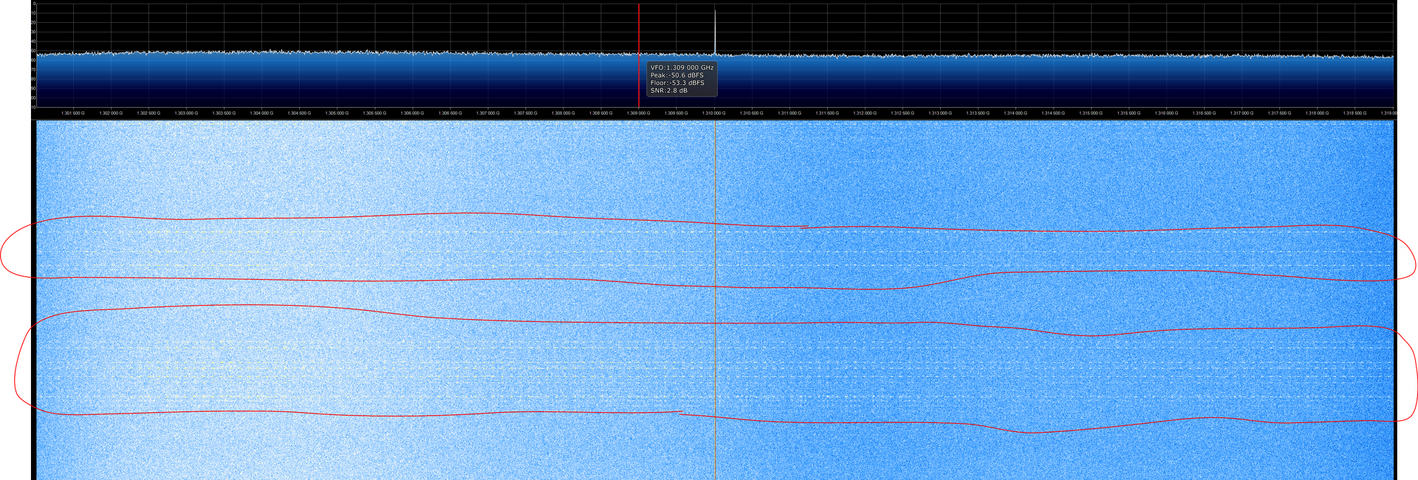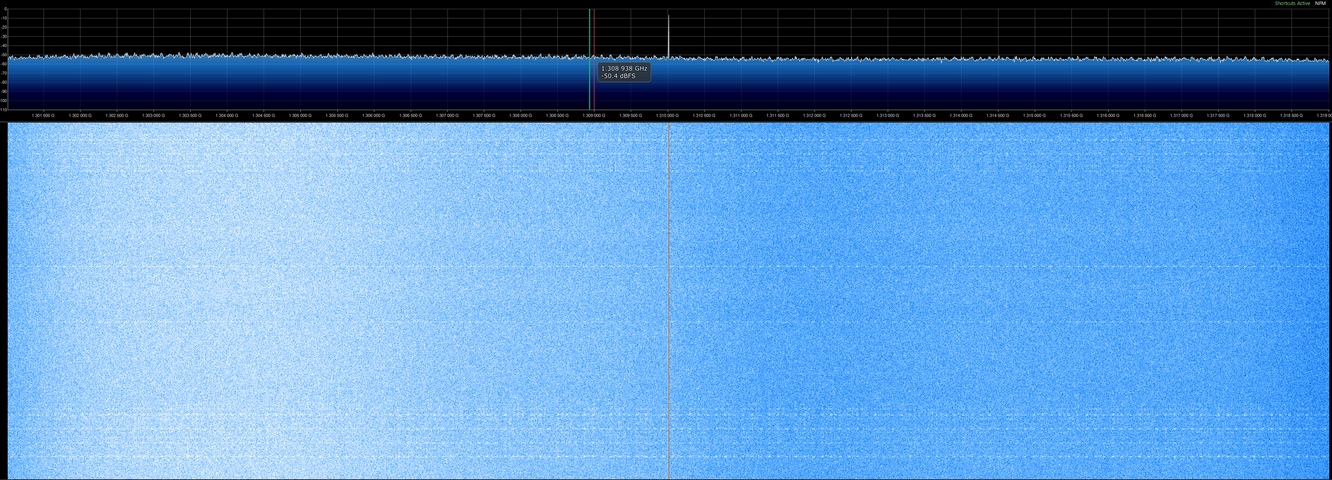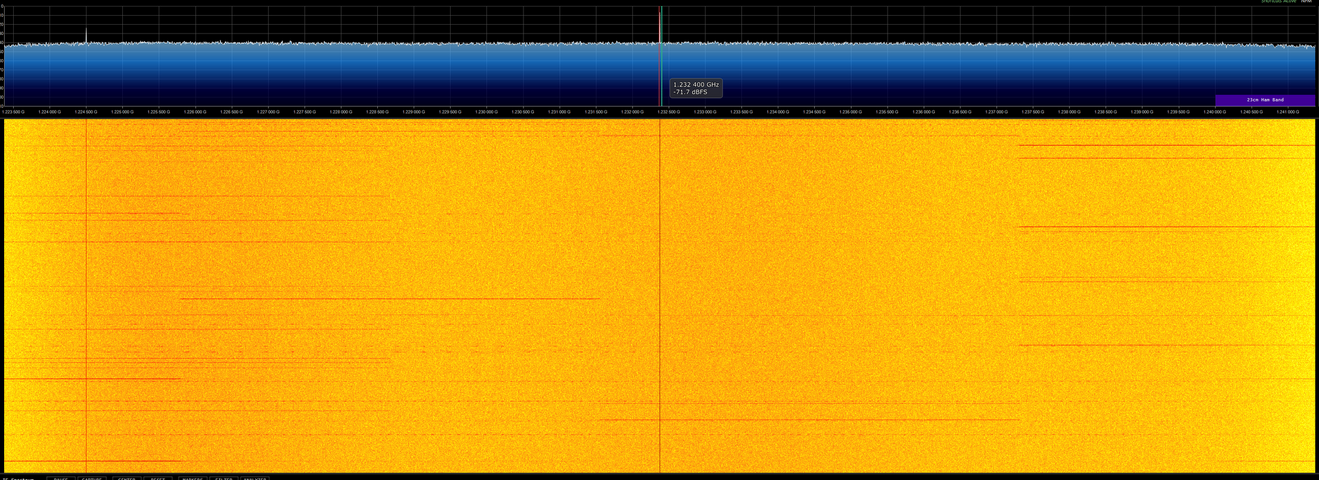I've noticed some odd interferences on certain C-band frequencies causing the receiver to lose lock on the transponder. Does anyone know what the possible interference circled in the red box might be? The frequencies displayed in the image are downconverted, and the LNB is a Titanium Satellite - C1-PLL C138 with a 5G filter.
Need help to identify unknown interference
- Thread starter caramel
- Start date
- Latest activity Latest activity:
- Replies 17
- Views 3K
-
HAPPY NEW YEAR! EXCITING CHANGES COMING IN 2026!
Thank you for a great 2025 and we are so looking forward to 2026!
PLEASE CLICK HERE to find out about some of our plans for 2026 including our BRAND NEW NAME we will be moving to in 2026! Exciting times are ahead!
Happy New Year from your friends here at SatelliteGuys.US!
You are using an out of date browser. It may not display this or other websites correctly.
You should upgrade or use an alternative browser.
You should upgrade or use an alternative browser.
Need more information than still screenshots of carriers occurring within the bandpass frequency range of the LNBF.I've noticed some odd interferences on certain C-band frequencies causing the receiver to lose lock on the transponder. Does anyone know what the possible interference circled in the red box might be? The frequencies displayed in the image are downconverted, and the LNB is a Titanium Satellite - C1-PLL C138 with a 5G filter.
Are these originating from a satellite? Terrestrial? Duration? Carrier width? Varying amplitude? Modulated? What transponders are affected? Complete transponder loss? Random micro-blocking? Fluctuating loss of decoding?
Having the same here on 101. I didn't realize that most of what I recorded today was unwatchble so I wasn't able to monitor it tonight around midnight. on 4180 The SNR stayed around 92% and no BER and the AGC level on the Edision may have dropped under 49Need more information than still screenshots of carriers occurring within the bandpass frequency range of the LNBF.
Are these originating from a satellite? Terrestrial? Duration? Carrier width? Varying amplitude? Modulated? What transponders are affected? Complete transponder loss? Random micro-blocking? Fluctuating loss of decoding?
I am a fairly good ways from the closest 5G flamethrower and it's not a direct LOS to the dish at all. I'm thinking maybe an adjacent satellite and a similar carrier coming up at times causing as this is the first time in quite a while it has made things this bad. Guess a good look with the SA is forthcoming.
With as many signals s there floating around these days if we could see em we couldn't see our hands in front of our faces
As noted by others, there was a change in FEC setup on 4180 MHz two or three days ago.Having the same here on 101. I didn't realize that most of what I recorded today was unwatchble so I wasn't able to monitor it tonight around midnight. on 4180 The SNR stayed around 92% and no BER and the AGC level on the Edision may have dropped under 49
I am a fairly good ways from the closest 5G flamethrower and it's not a direct LOS to the dish at all. I'm thinking maybe an adjacent satellite and a similar carrier coming up at times causing as this is the first time in quite a while it has made things this bad. Guess a good look with the SA is forthcoming.
With as many signals s there floating around these days if we could see em we couldn't see our hands in front of our faces
If you have not done so, re-scan this Weigel transponder. I find that it is now considerably stronger
in quality reading, and all channels have returned.
Thanks for the info on the FEC rate change I wasn't aware of that one.
I went ahead and disassembled the unit and didn't see anything obvious except maybe a couple of solder joints at the board for it was questionable. I cleaned off the old hard heat sink compound from the processor and heat sink and replaced that with new product. Out of Arctic Silver so it got the regular white version. I've used it on transmitter pa applications and had good results. Thanks again for the heads up
Wt
I went ahead and disassembled the unit and didn't see anything obvious except maybe a couple of solder joints at the board for it was questionable. I cleaned off the old hard heat sink compound from the processor and heat sink and replaced that with new product. Out of Arctic Silver so it got the regular white version. I've used it on transmitter pa applications and had good results. Thanks again for the heads up
Wt
Still having problems with this particular carrier. Seems worse in the day time hours but I'm getting 92% CNR at both time slots.
I've noticed similar problems on a couple satellites. One of them will play fine all day, and then start acting up toward evening. On the other one, about half the channels will drop clear out.Still having problems with this particular carrier. Seems worse in the day time hours but I'm getting 92% CNR at both time slots.
A few hours later, they'll be back. I almost deleted them once, thinking they had moved or changed transponders.
When they're on, they have a 95/85 signal level. I did move a 10 footer when Le Sea left, rolling it down to 127W so the wife can watch Reelz.
It was cutting up something fierce on the 7 1/2 footer. I also also rolled the 97W dish down to take the place of another 7 1/2 footer.
The selection gets smaller by the day. Before long, I may have a lot of scrap aluminum laying around. They just installed fiber on our road and we're waiting for them to hook it up and test it.
I really don't need a half a gig, but I'm taking it and their phone service. It should be operational sometime next week.
IMO, that's a clear sign of intermittent 5g interference.One of them will play fine all day, and then start acting up toward evening. On the other one, about half the channels will drop clear out.
A few hours later, they'll be back.
Another possibility is a drifting LNB or LNBF. Could be temperature sensitive, but more likely would be the LO drifting when the LNB/LNBF is directly in the sun. Take a small plastic garbage can and slide over the device, and see if the problem goes away. If this is the cause, it is either LNB replacement or in the case of super sensitive and weaker signals, cover everything. If you have a dark colored weather cover, paint it flat white with a spray can. One can often duplicate thermal drifting problems by getting a hair dryer close, but not too close, to the electronics and see if things drift. Before spending any money on filters or anything else, check out the above basics---old electronics is often not stable enough to deal with DVB-S2 digital signals. Good luck.IMO, that's a clear sign of intermittent 5g interference.
I'm curious. As I posted before, I had some interference once in a while that wasn't a major problem since it came and went.
I've been noticing lately that the problem has grown larger. MeTV and the others on that satellite, NEVER had a problem with the picture breaking up, or pixelating.
Most of the other satellites were the same way, but something has happened, and it's been just recently. Did they expand the 5G coverage to other satellites?
Now, I have interference on all 6 of my 8 dishes (Ku band excluded) to the point most channels will be fine one minute and exhibit a complete loss of signal the next. Many channels have become unwatchable.
I've done some investigating to see if there are new 5G towers, and there are none. We live 10 miles out in the country, with mountains on all four sides, and it seems the only logical explanation would be satellite based 5G coverage.
We have one cell tower we can hit, a 5G AT&T tower and that's it, but it's never been much of a problem, and it never trashed the signal on every satellite.
This time around, there are no channels that are exempt from this problem. What do you think. Has the 5G nightmare finally crept into our mountain homestead?
I've been noticing lately that the problem has grown larger. MeTV and the others on that satellite, NEVER had a problem with the picture breaking up, or pixelating.
Most of the other satellites were the same way, but something has happened, and it's been just recently. Did they expand the 5G coverage to other satellites?
Now, I have interference on all 6 of my 8 dishes (Ku band excluded) to the point most channels will be fine one minute and exhibit a complete loss of signal the next. Many channels have become unwatchable.
I've done some investigating to see if there are new 5G towers, and there are none. We live 10 miles out in the country, with mountains on all four sides, and it seems the only logical explanation would be satellite based 5G coverage.
We have one cell tower we can hit, a 5G AT&T tower and that's it, but it's never been much of a problem, and it never trashed the signal on every satellite.
This time around, there are no channels that are exempt from this problem. What do you think. Has the 5G nightmare finally crept into our mountain homestead?
There is no satellite based 5G in the C-band frequency range. The 5G C-band frequencies are terrestrial based.
Time to hook a spectrum analyzer to your LNB and see confirm the presence and source of the interference. You will likely observe carrier spikes above 1170 MHz IF (3980 downlink - 5150 LO = 1170 IF)
Time to hook a spectrum analyzer to your LNB and see confirm the presence and source of the interference. You will likely observe carrier spikes above 1170 MHz IF (3980 downlink - 5150 LO = 1170 IF)
Actually, I located the problem this afternoon. A while back, I changed the feed line from the switch to the receiver.IMO, that's a clear sign of intermittent 5g interference.
All of the cable I have is fairly rigid, and to avoid putting undue strain on the receiver's input, I used a short jumper made of RG59.
I actually found the problem when I dusted the receiver and the signal went out when I moved the wire.
The connection was still snug, but apparently after being hooked up using RG6 previously, it must has stretched the fingers inside the connection to the point the smaller stinger wasn't making good contact.
After moving the receiver out on the shelf to avoid stressing the connection with a new piece of RG6, and fastening the RG6 to the shelf to stabilize it, everything is now back to normal.
I appreciate the replies guys. Thanks for everything. Have a good one.
Unfortunately, when we closed the business, I sold my spectrum analyzer and I've regretted it. I could have used it several times moving a dish to different orbital slot.There is no satellite based 5G in the C-band frequency range. The 5G C-band frequencies are terrestrial based.
Time to hook a spectrum analyzer to your LNB and see confirm the presence and source of the interference. You will likely observe carrier spikes above 1170 MHz IF (3980 downlink - 5150 LO = 1170 IF)
So, after selling it, I was back to hunting satellites the hard way, which can be quite a pain with digital signals.
Now, I program each active transponder, move the dish until the channel pops on, and I'm all set, well, sort of.
There are some channels with the same PID information that come on, but that's quickly resolved when I look at the channel ID on a few different channels.
It's kind of "cavemanish", but it works OK. I would still like to have my analyzer back. Much more simple with it. Have a good one.
Only 2 of my 8 dishes have covers over them, and both were painted white several years ago.Another possibility is a drifting LNB or LNBF. Could be temperature sensitive, but more likely would be the LO drifting when the LNB/LNBF is directly in the sun. Take a small plastic garbage can and slide over the device, and see if the problem goes away. If this is the cause, it is either LNB replacement or in the case of super sensitive and weaker signals, cover everything. If you have a dark colored weather cover, paint it flat white with a spray can. One can often duplicate thermal drifting problems by getting a hair dryer close, but not too close, to the electronics and see if things drift. Before spending any money on filters or anything else, check out the above basics---old electronics is often not stable enough to deal with DVB-S2 digital signals. Good luck.
The rest have water tight connectors with dielectric compound in them. On top of being super hot inside, they're excellent bee condos.
Over the 30 years in we were business, I had my butt ate alive several times by hornets and yellow jackets, so I ditched the covers.
They're supposed to be bee proof, but after being on a few years, they find a way in. I thought of frequency drift, and was headed that direction, but I couldn't see all the LNBS drifting at the same time.
Anyway, the problem's resolved and everyone's happy. Thanks.
If you have issues with bees or wasps inside a weather cover, I can suggest an old-school remedy:
buy a small package of moth balls. Place them inside the enclosure within a mesh bag. It also creates a smell that birds do not like, should you have an issue with that. Good luck!
Mike
buy a small package of moth balls. Place them inside the enclosure within a mesh bag. It also creates a smell that birds do not like, should you have an issue with that. Good luck!
Mike
Here is a great SA that I have for my collection of gear - TinySA Ultra - Only $149 Prime
www.amazon.com/ALIESTFDNO-Upgraded-Spectrum-Frequency-Generator/dp/B0D3GYBXMH
www.amazon.com/ALIESTFDNO-Upgraded-Spectrum-Frequency-Generator/dp/B0D3GYBXMH
Thumbs up on the tinySA. Just look out for clones. That, NanoVNA, and DSO-TC3 are in my go-bag along with a box-o-connectors and adapters. They "get you there" before going to grab the big guns.
I used moth ball at remote radio site and had good luck with the bee population also. I didn't get any in my new new enclosure and now I'm kinda wondering whether I should inspect soon or wait till it's about 10 degrees outside which will be way too soon for my likingIf you have issues with bees or wasps inside a weather cover, I can suggest an old-school remedy:
buy a small package of moth balls. Place them inside the enclosure within a mesh bag. It also creates a smell that birds do not like, should you have an issue with that. Good luck!
Mike
Similar threads
- Replies
- 23
- Views
- 2K
- Replies
- 8
- Views
- 529
- Replies
- 1
- Views
- 528
- Replies
- 1
- Views
- 839
Users Who Are Viewing This Thread (Total: 0, Members: 0, Guests: 0)
Who Read This Thread (Total Members: 94) Show all
- caramel
- one_db_compression
- adam122
- jdavid22
- Houston Rockets
- arlo
- Morbius
- Gulcher
- N6BY
- Panavision
- Lajaba
- jorgek
- orac
- done
- cyberham
- voomvoom
- Brct203
- gms49ers
- LRE
- SatPhreak
- sgs
- PrunePicker
- stecle
- Pepper
- mc6809e
- anto@
- clucas
- waylew
- juventusbrown
- primestar31
- phlatwound
- armadillo_115
- Juan
- dl76
- mikekohl
- RaiderPower
- Mr Tony
- Elsguy
- Mike045
- Titanium
- FTA4PA
- catamount
- a33
- Bassplayer 1964
- northgeorgia
- Vintagesports
- Borisov-54
- lost_mesa
- Martyn
- MrMars
- KennyR
- mr3p
- harshness
- AZ.
- Cobra
- Radioguy41
- Keith Brannen
- telstar_1
- TRG
- Lobo70
- Jim5506




